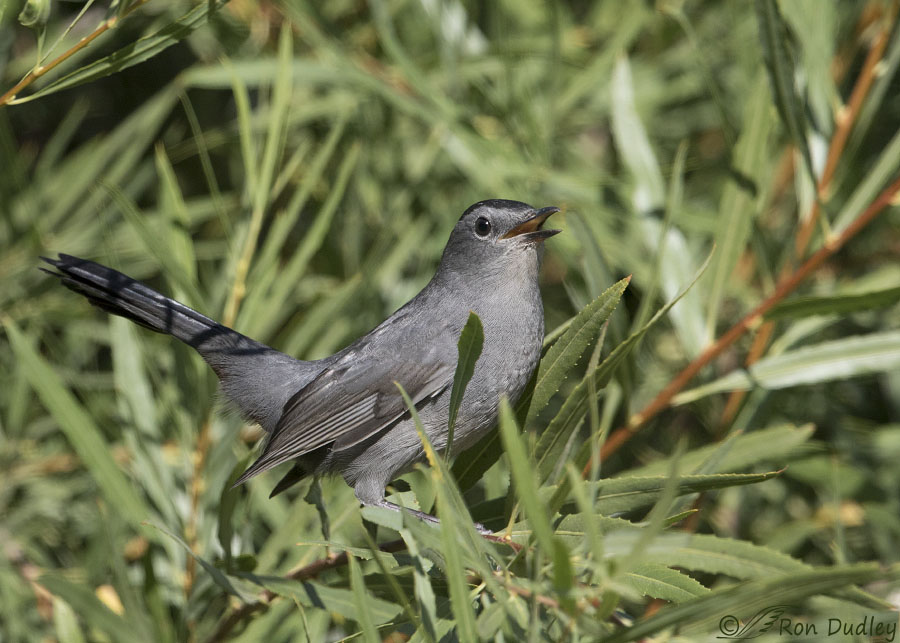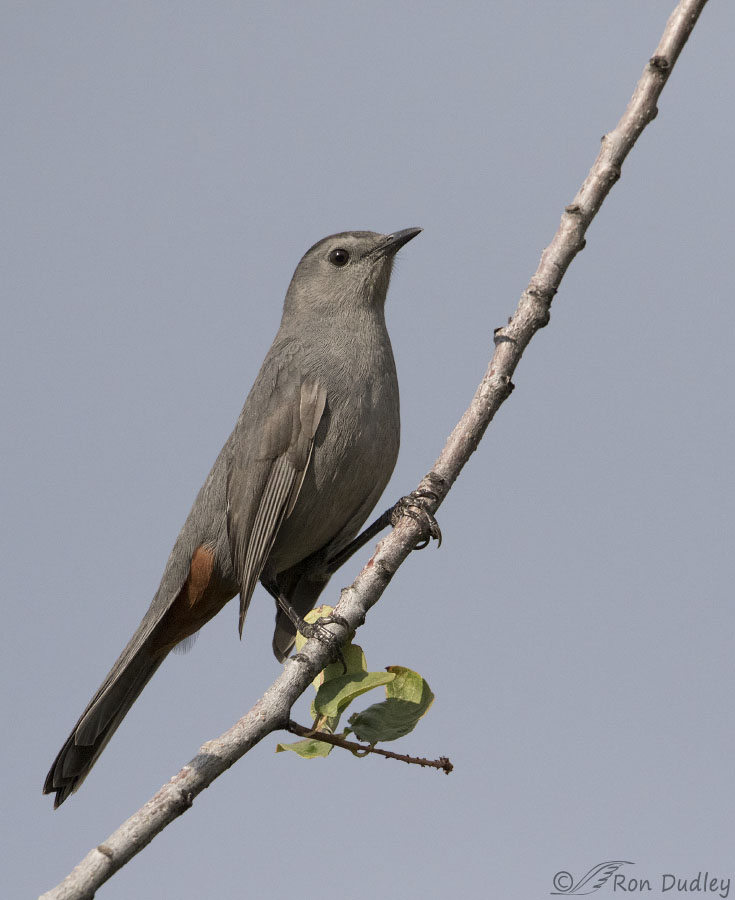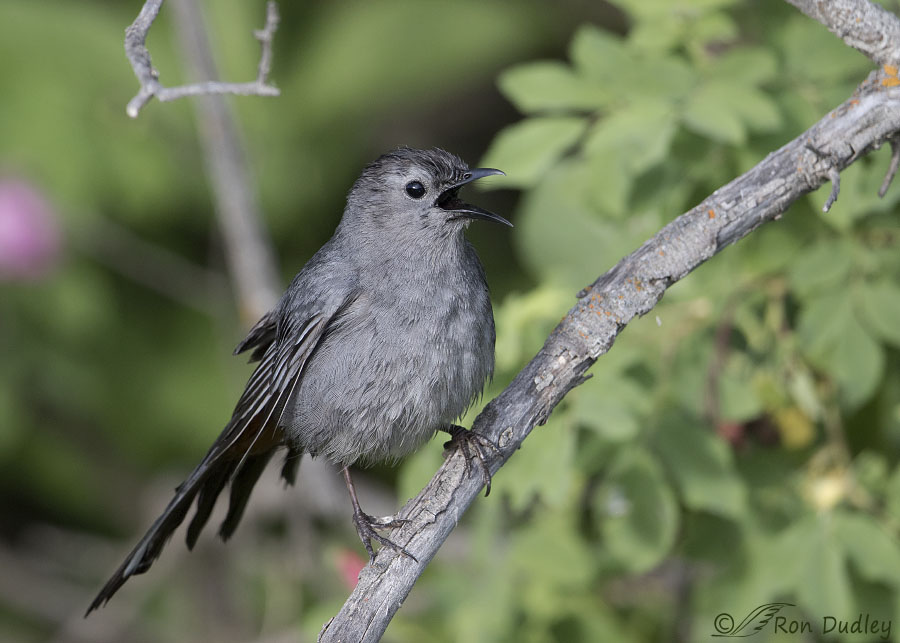Gray Catbirds are an elusive subject for me so I chalk up every decent shot I get of one into the victory column. All three of these photos were taken in the Wasatch Mountains in the same general area.

1/1600, f/6.3, ISO 500, Canon 7D Mark II, Canon EF 500mm f/4L IS II USM + EF 1.4 III Extender, not baited, set up or called in
Many bird photographers categorize their photos as either “bird in habitat” or “bird on a stick” – BIH or BOS. This one is definitely the former. In fact there might be too much habitat here for some, especially because some of it is in front of the body of the bird. But I still like the calling, perky pose of the catbird.

1/8000, f/6.3, ISO 800, Canon 7D Mark II, Canon EF 500mm f/4L IS II USM + EF 1.4 III Extender, not baited, set up or called in
And this is definitely a bird on a stick. I believe most folks prefer BIH over BIS but the latter has its place. Photos meant to best demonstrate the field marks of a species are often BIS because those types of shots tend to give us a better look at the physical features of a bird and there’s very little else to distract from the bird. For that reason field guides often use BIS photos or paintings.

1/640, f/6.3, ISO 800, Canon 7D Mark II, Canon EF 500mm f/4L IS II USM + EF 1.4 III Extender, not baited, set up or called in
I suppose it could be claimed that this photo is a combination of both but I’d call it BIH. The catbird had recently taken a bath and was still trying to dry off, thus the fluffed up feathers.
This has been a good summer for me for both Gray Catbirds and Yellow Warblers. I didn’t have squat for decent images of either of them until fairly recently so setting goals and doggedly pursuing them can eventually pay off.
Maybe next summer I should work on Carolina Parakeets and Ivory-billed Woodpeckers (said tongue in cheek of course).
Ron
Note: I found it fascinating to learn that Carolina Parakeets were probably poisonous. This from Wikipedia (several other sources say the same thing): “Carolina parakeets were probably poisonous—American naturalist and painter John J. Audubon noted that cats apparently died from eating them, and they are known to have eaten the toxic seeds of cockleburs.
Correction: I realized after I published this post that the first image above isn’t “recent” after all – it was taken almost exactly a year ago. Sorry about that…


I’m so glad you were able to get beautiful pictures of the bird(s)..We don’t have them here. They do have a pretty song. Thanks Ron!
Thank you, Jean.
I am with Marty. Bird in Whatever works for me. With a small preference for BIH.
All reference to Carolina Parakeets being poisonous refer back to Audubon’s single statement about cats being killed. Perhaps this was the result of eating birds that had just fed on a large number of cockleburs, which are toxic, but we have no way to test this idea. By eating the whole bird a predator could pick up a toxin just consumed by the bird. The only known truly poisonous birds (whose feathers are toxic) are a small number of species belonging to the genus Pitohui (Hooded and Variable the most toxic) and the Blue-capped Ifrita, all from New Guinea, and the Crested Auklet. In each case, special biochemical mechanisms must be in place in order for these birds to not poison themselves as they preen their feathers. Also, the poison in these birds is not produced by the birds themselves but comes from sources regular in the diet. (Pitohui and Ifrita eat beetles, which probably obtain their poison from plant sources, and Crested Auklets most likely obtains a very different poison, an aldehyde, from phytoplankton.) The poison becomes incorporated into new feather as they develop and grow.
Interesting stuff, Dan. It’s too bad, for several reasons, we can’t test Audubon’s statement today.
Beautiful series, Ron! During spring migration I was lucky to have six Catbirds hanging out in the yard for a few days, devouring the orange halves I put out for the Orioles. One pair eventuallý nested in my thickets and the youngsters were a joy to watch. I’ll sure miss hearing them when they’re gone.
That’s interesting, Diane. I had no idea they’d go for oranges but it makes sense because they sure like berries.
Wonderful series Ron!
Charlotte
Thanks, Charlotte.
I am always happy to see Gray Catbirds. I love the after bath shot. The first one rather derailed me with all those shadows on the tail. It looks like someone tied up the tail in heavy black string. Maybe I shouldn’t read your posts before breakfast?
Those shadows are probably from grass stems, Susan. I wish they weren’t there.
Elusive definitely, unless you are able to catch them nesting. But, they still are very hard to capture with my lens.
Wonderful images! Although I understand why people like BOS, I prefer BIH. I think it is interesting to know their habitat, the vegetation that they like as clues as to where one can find them.
Thanks for sharing!
Agreed, Dick. BIH tends to tell the viewer a lot more about the bird. Thank you.
The first photo is flat out beautiful no matter when it was taken! Caught the whole thing, great bird posture/color/habitat. I’m in the BIH camp and REALLY is the BIW camp
I’m in the BIH camp and REALLY is the BIW camp  BIS is great for identification but doesn’t tell much else about the bird…….
BIS is great for identification but doesn’t tell much else about the bird…….
Thanks, Judy. I like that shot very much too.
Good morning Ron. Nice photos. They are really handsome birds – wish we had them here.
Everett Sanborn, Prescott AZ
PS: saying good morning I was thinking that you are probably an hour ahead of us – as you know AZ does not observe daylight savings 6:05 am now
Thanks, Everett. Yes, we’re an hour later than you are.
The elusive catbird! I really like all three poses here…perky, pensive, and chatty! Nice catch with the rufous butt…I always like seeing that. I agree with ‘Marty K’…any bird is great as long as it is ‘au natural’! Sometimes though that ‘stick’ is ‘man-made’ and is a distraction but not much can be done; they have become so much a part of the natural habitat. Oh for the days of wooden poles! A few days ago I sat for almost three hours along side a small stream waiting for a few Belted KingFishers to return; there were a few Catbirds playing with me from the shrub willows along side the stream. They called, mewed, rustled the leaves, etc. but never showed them selves! Several other species popped out but those darn ‘cats’ just stayed in the bushes!
“those darn ‘cats’ just stayed in the bushes!”
Yes, that’s usually my experience with them too, Kathy. Frustrating.
And I always enjoy seeing those rufous undertail coverts. We can’t see all of them well in that shot but often you can’t see any of them.
I’m in the “BIW” (bird in whatever) camp! The first shot is my favorite for the perky pose, although I like the rumpledness of the bird in the last shot and the angle of the BOS shot. Aw, heck, they’re all great!
Thanks, Marty. When I was a neophyte bird photographer I nearly always preferred BIS but my tastes have evolved and now BIH is my favorite.
Nice stuff Ron! Honestly, I do prefer “BIS” whenever I can get it, but since I prefer getting portraits of my subjects it’s probably just me. If I had known you needed help finding Gray catbirds, I would’ve suggested a trip to Georgia! They’re everywhere here, especially in winter when they need to forage in (Comparatively) open habitat. Plus you could maybe even find your parakeets or woodpeckers here
I’d make that trip for the parakeet and/or woodpecker, Xavier!
You’re not alone about preferring BIS but I think more folks are in the other camp. Thank you.